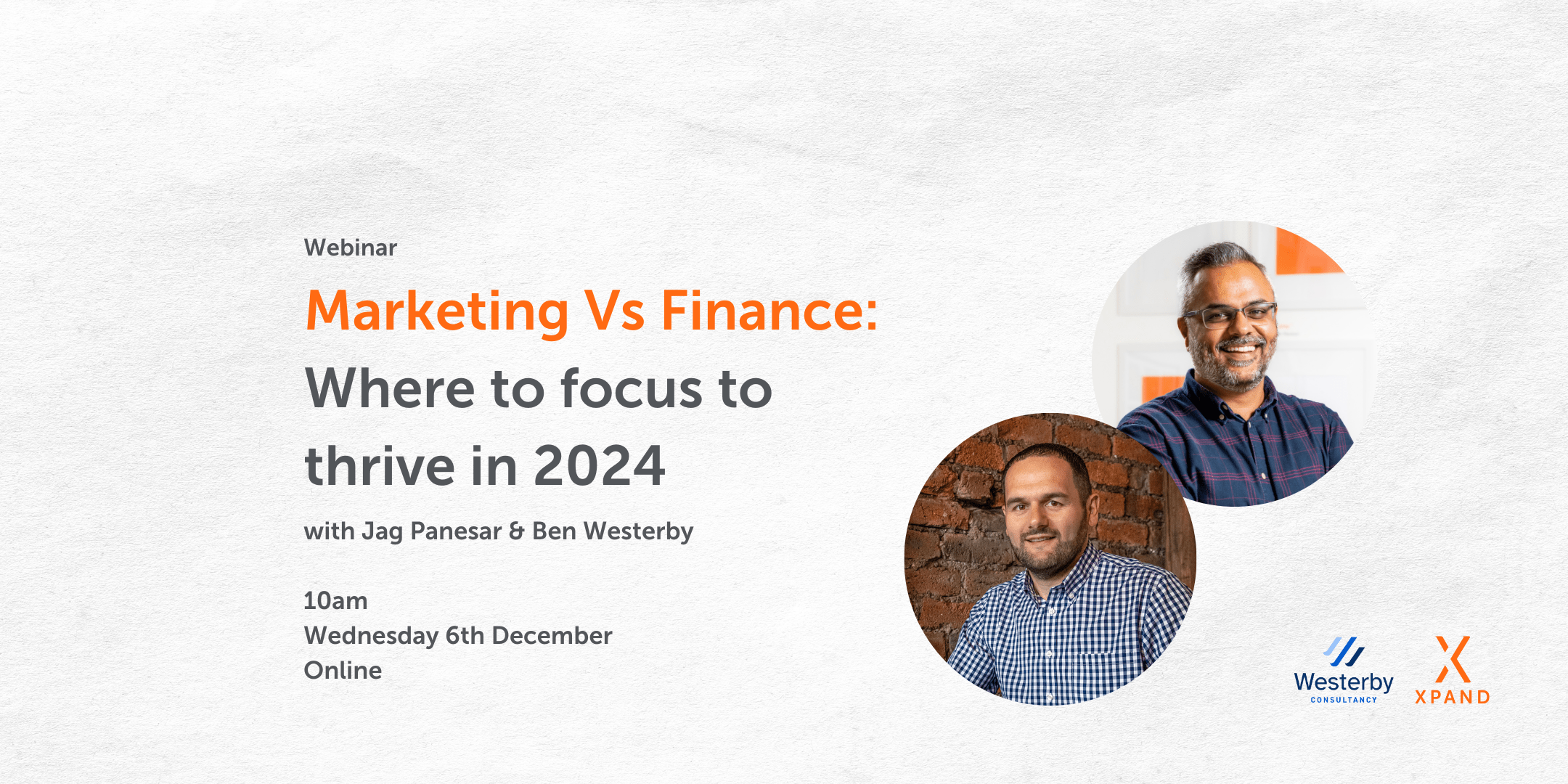Did you know that 44% of b2b marketers use buyer personas, creating a mix of opportunity and competition?
So, if you’re not using them, you’re missing a trick.
In this blog, I’m going to cover:
- The importance of audience buyer personas, what they are and why you need them
- 5 reasons why they fail
- Where to start and what to include
- Some recommended resources to make your life a little easier
The seven stages to achieve marketing success
At Xpand, we use a process called SOLAR7 as a framework, to work with our clients to achieve a positive return on their marketing investment.
Creating audience personas falls under stage 2 of our 7-stage process. They are crucial at this stage to be able to create a strategy that’s in line with your core business objectives.
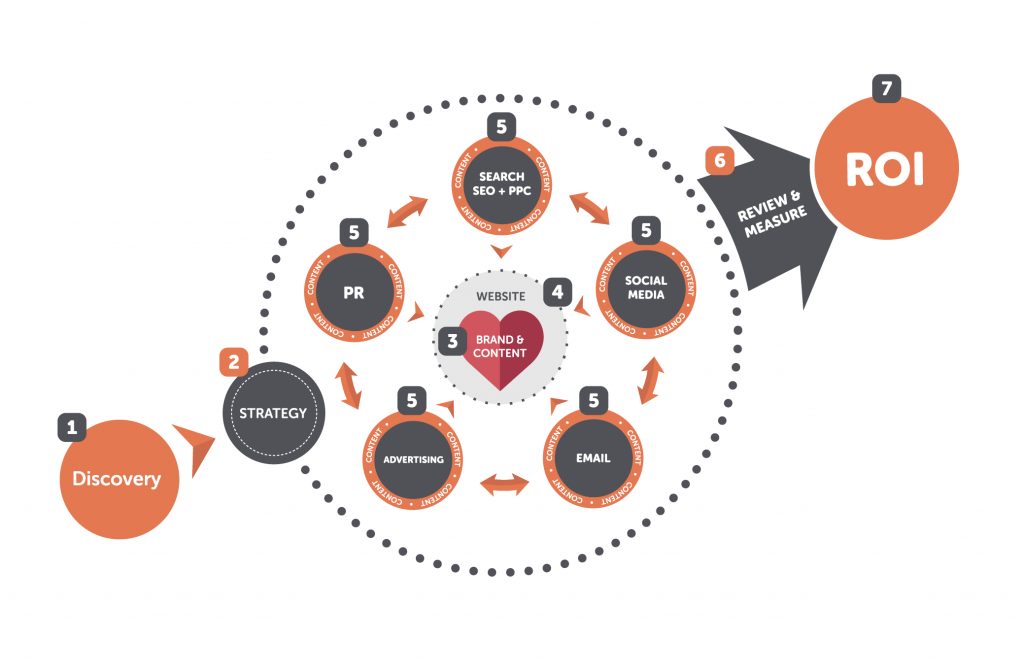
The importance of audience buyer personas
What is an audience persona?
“A buyer persona is a research based profile that depicts a target customer. They describe who your ideal customers are, what their days are like, the challenges they face and how they make decisions”
Social Media Today
Social Media Today’s definition is a slightly simplistic approach. Ours however, goes into a little more detail:
“It’s an in-depth description of someone who reflects your target audience. It’s not a real customer, but a fictional person, representing the characteristics of your potential customers”.
Think about your own business, who is the ideal person that you want to reach through your marketing?
It’s also important to note that audience personas can be used for more than just marketing. They act as a framework and should be central to any efforts within your business. Make sure you’re sharing this information with your sales team so they can use it to help build relationships with potential customers. They will also help you to identify and prioritise changes to your offering based on what your customers need the most.
You can also use them to build effective strategies and facilitate the buying process. Using these personas will help you to understand where it’s best to communicate with your customer. For example, there’s no point in marketing on social media platforms that your audience aren’t using.
5 Reasons why they fail
As we’ve discussed, audience personas can be effective if done right. However, there are some common mistakes that people make:
1. You don’t think you need to document the personas because they’re already in your head.
As a business manager, are you guilty of thinking that because you have the persona clear in your head, you don’t need to put pen to paper?
We’ve found that a lot of people do this. Often, people are confident that their team knows who the target customers are, without any documentation saying so.
2. They aren’t actively used by everyone in the business
So, you may have your target persona documented, but you’re not sharing this out to the rest of the team.
For example, a business might have a good idea of who their customer is, but not show this in their website copy. Here, we often find that businesses mistakenly still focus on what they do, rather than what the customer needs.
Filtering the audience persona information out to the departments within your business can help prevent this from happening and keep your touchpoints with the customer consistent.
3. You don’t ask ALL your team for their input when they’re speaking to your target audience
This is a big one. We find that most businesses tend to sit down with the management team to discuss who they believe is the ideal customer. But, how frequently are these team members dealing with customers? Probably very rarely in comparison to other people in the business.
Your sales team, your customer service team and your marketing team, whoever you’ve employed to deal with your customers, are in direct contact with them every day. So, it’s important that they have an input in this, because they might have some credible information that you’re missing.
4. You only have one
This is debatable and can be argued, depending on your business.
Unless you have a boutique business, you’ll have more than one persona. Even in B2B, there’s usually more than one type of customer you’re trying to attract.
Also, what a lot of businesses forget is that you can use them for recruiting too, to consider who your ideal employee is. So really, no one should have just one. Ideally, you should have at least one for your ideal customer and one for your ideal employee.
It’s very rare that you’d only be targeting one industry too. In this case, you’d need more than one persona to effectively understand each of the audiences.
5. You don’t revisit them- we’re in a global pandemic people!
I think we’re all guilty of this. Make sure you’re revisiting your audience personas. Once you’ve created them, it’s not enough to just leave them.
It’s important to remember that we’re in a global pandemic and people have changed. Covid-19 has impacted everybody at some point, and your customers are feeling it too.
We suggest assessing your personas quarterly and pushing the updated information out to the rest of your team.
Where to start and what to include
Do your research
Use your current data
A lot of your social media and website analytics will give you this information. Facebook is great for giving you audience insights, you can see the time your audience is online and the content they’re engaging with.
You should also consider any trends within your business or the industries you’re targeting. For example, if the industry has a particular time of year where they’re busier, you might want to consider your messaging to account for more stressful periods. Your data will potentially help you to identify these changes.
Ask your current customers
Something that a lot of people forget to do- talk to your existing clients!
Like I’ve already said, your customers will have changed over lockdown. An easy solution to understanding how they’ve changed is to pick up the phone and ask them. Doing this, you can ask questions like:
- How did the pandemic affect you business?
- Have you been using social media more?
- Have you changed any of your processes?
You could even send out a survey. This can give you valuable insight into their behaviour changes and the best channels/ approaches for communicating with them.
Using social media
LinkedIn you can use the search function to get a good idea of your persona. Use the filter option to narrow down job titles and industries to have a look at real life profiles that reflect your target audience. We find this useful for finding information on key skills, influencers and personal attributes.
If you’re worried about people seeing that you’re viewing their profile, there is a setting on LinkedIn that allows you to privately view other profiles without them knowing.
Creating your profile
Where to start:
There’s been a bit of a debate recently on LinkedIn as to whether you should be giving your personas a name. We think you should because it gives more of an accountability if you can then refer to that person in everything you do, across the business. We also suggest finding a photo that best represents them as this helps to give them a personality and again, more accountability to the team.
What to think about:
Think about what their key identifiers are. For example, are they hard-working? For inspiration for this section, think about the customers you work with now and what their traits are.
Consider their personal life. Are they a parent? Do they like to learn? These are important factors to consider that can affect how best to communicate with your audience.
What are their goals in life? It’s important to consider both personal and professional goals to get an in-depth understanding of the individual.
What are their primary challenges and pain points? We usually find that time is a common pain point among most people. But, you could also consider other factors such as ‘difficulty with having a work-life balance’.
Where might they go for sources of information? This is where research with your current clients will be really useful because you can ask them where they would seek out information. If you’re not asking your customers directly, you could use the LinkedIn ‘hack’ we discussed above.
Who are their influencers? A lot of people often ask me why this matters. But, if you know who their influencers are then it might help understand the type of content they will respond to.
What next?
Create a PDF document and share it with the whole team. It’s really important to set aside some time to work through the personas you’ve created to make sure they’re right. Getting them involved in the process will hopefully benefit your employee engagement and employee advocacy too. If they’re all on board, and they know that that target customer is the focus, how much easier will it be for everyone in your business to be aligned? And like we said, you can use it as a working document that you embed into your content creation strategy.
Our example persona
If you were wondering what an audience persona looked like, here’s an example that we’ve created.
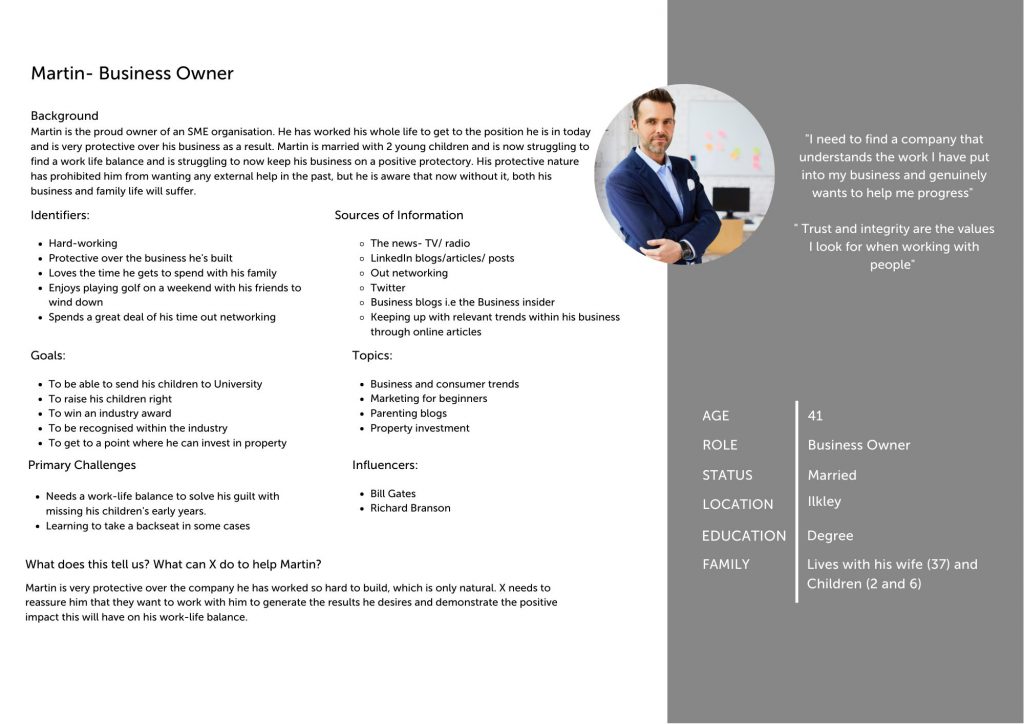
If you’re wanting to have a go at creating your own audience personas, download our free guide for “How to create an audience persona”.
A case study
Marketing sherpa, a marketing research agency, conducted a case study and found that buyer personas added the following value:
- A 900% increase in length of visit
- A 171% increase in marketing-generated revenue
- A 111% increase in email open rate
- A 100% increase in the number of pages visited
This seriously highlights the positive impact audience personas can have on all areas of your business. If it’s not a process that your business currently uses, then we suggest it’s something you should consider implementing in the future.
Resources
Whilst we do create a lot of our audience personas using our own experience and data, sometimes it’s difficult to really get into the mind of someone you have no idea about. In this case, we use the following sources for support:
Crystal
This is a useful platform that uses DISC analysis. The tool can be applied to LinkedIn and when you create the profile, it will give you examples of questions you might want to ask the person. It will also give you information about how to best approach them and which will be the most beneficial for any touch points, on or off-line.
Click here to go to the Crystal website.
Pulsar
This is one you have to pay for. However, it does give you a wealth of information about your target customer including insights into any habits they might have. It also has a social listening function which is really important for listening to what your customer is saying and being there with the answers before someone else is.
Click here to go to the Pulsar website.
Google Analytics
This is a useful tool for seeing when people are on your website. You can use this information to provide some guidance for what time is best to post on social media, as it’s likely that if they’re on your website, they’ll have social media open in the background.
Click here to go to the Google Analytics website.
The feedback…
We asked for immediate feedback at the end of the webinar, here are the results:
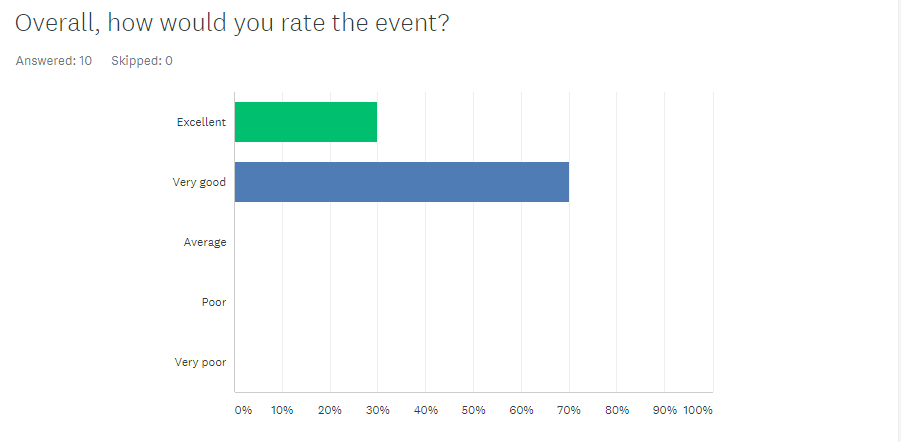
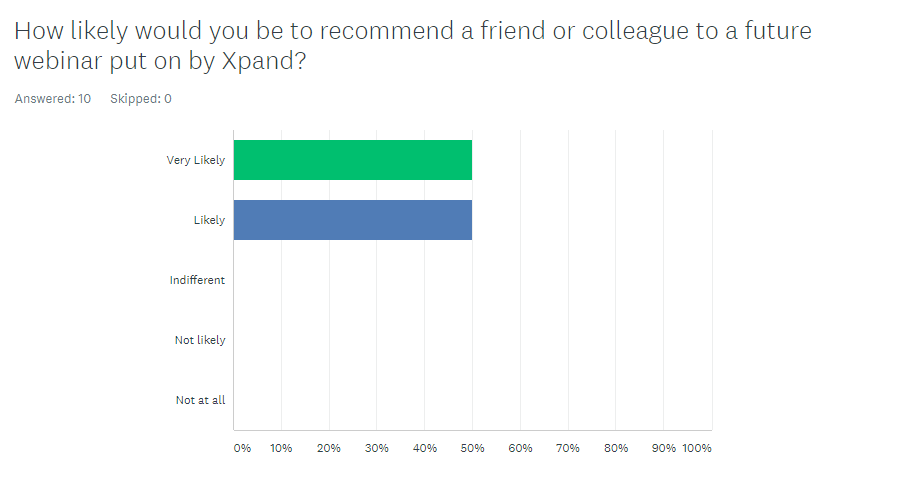
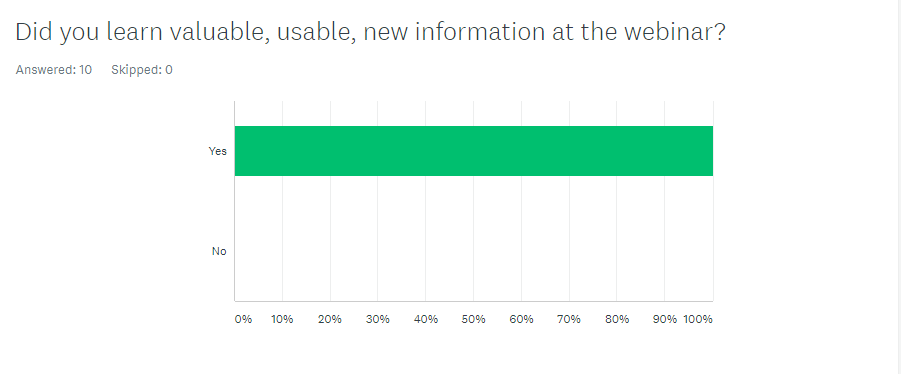
We hope that you’ve found this blog useful. If you would like any further help with understanding your audience and creating your personas, get in touch with one of our team members.

